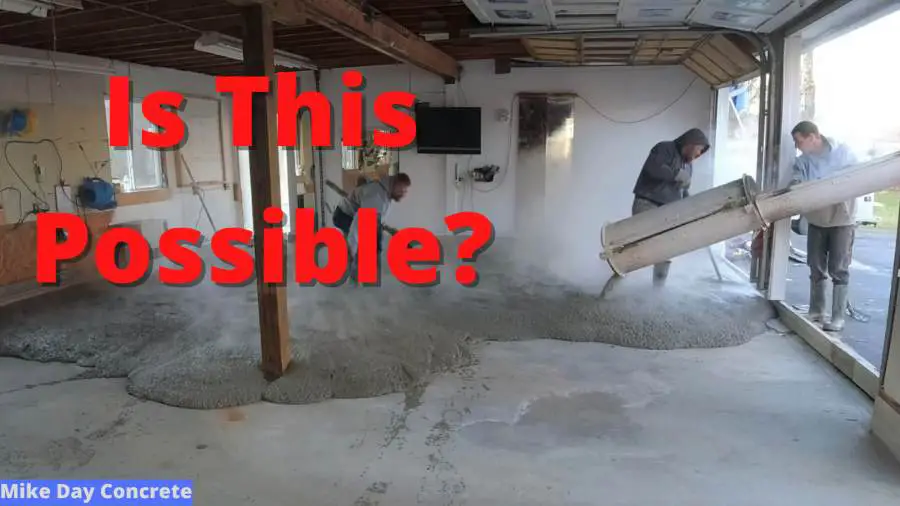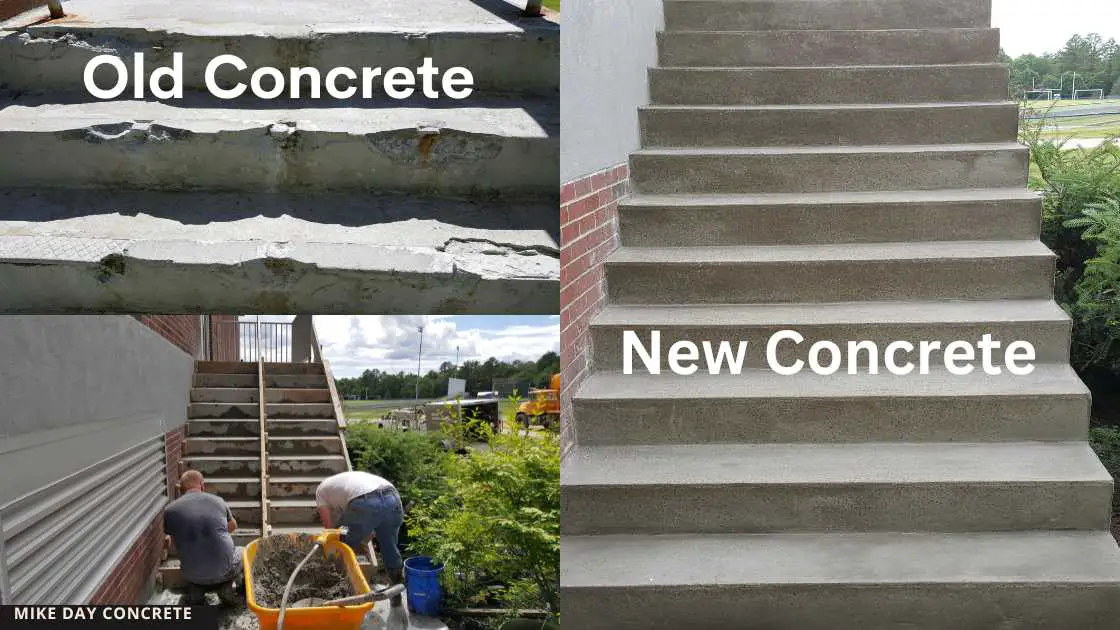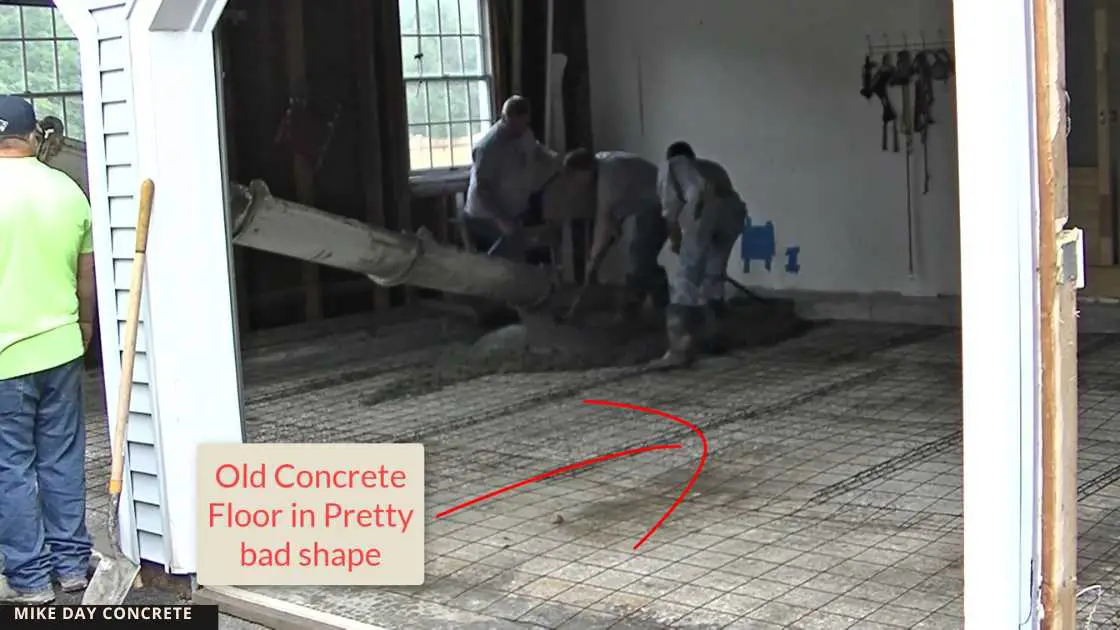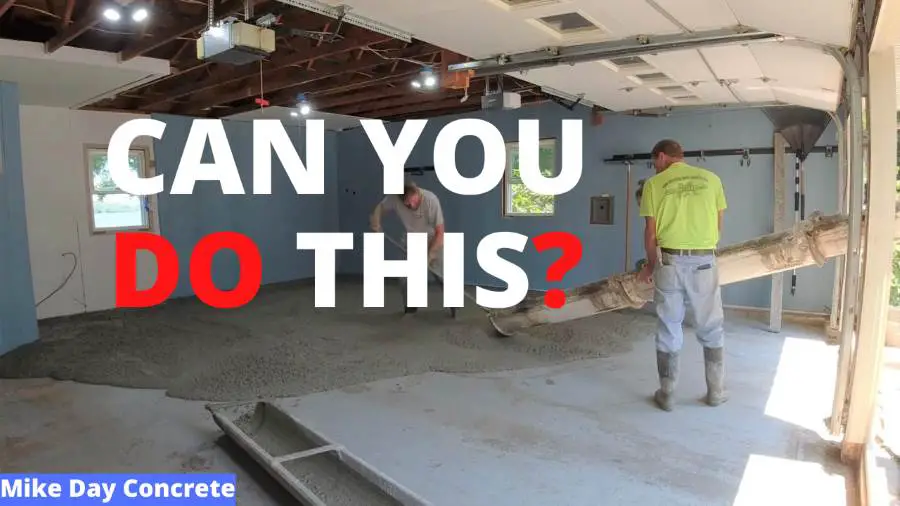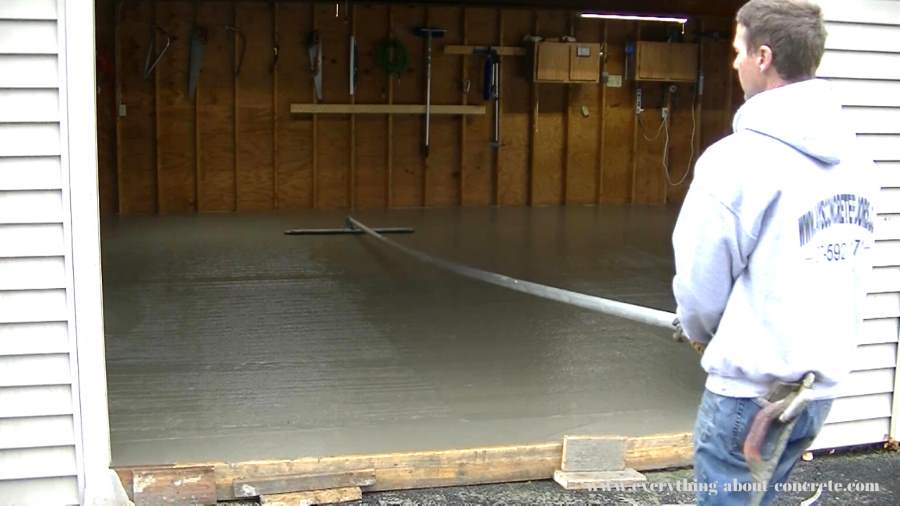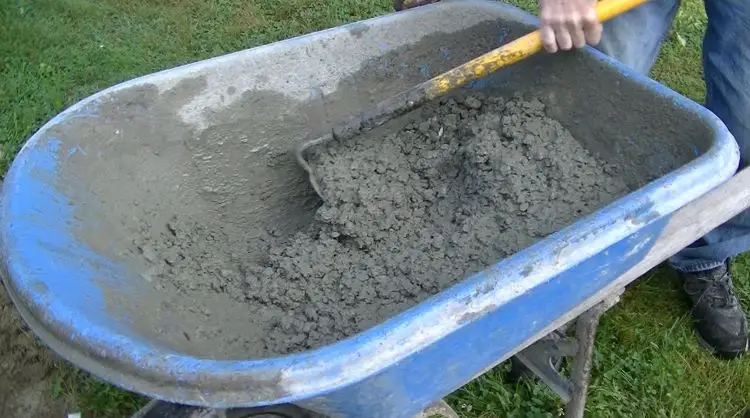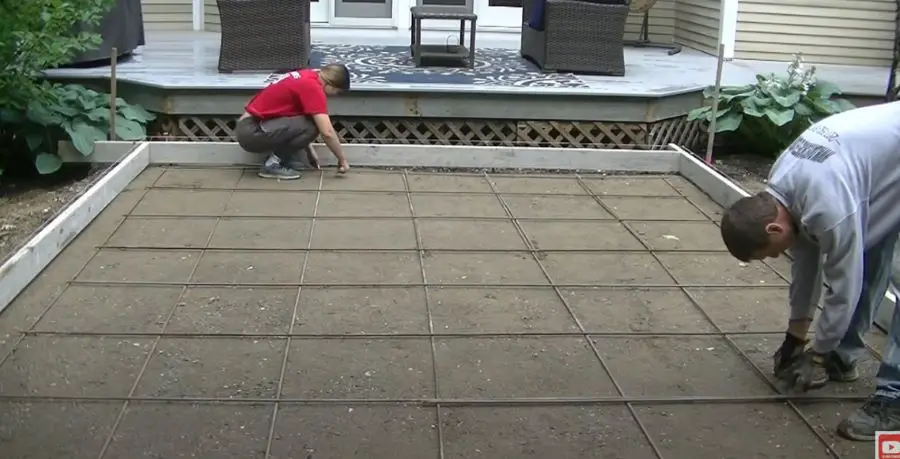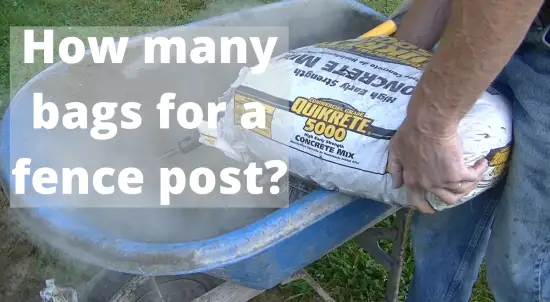Can You Pour Concrete Over Existing Concrete?
Can you pour concrete over existing concrete?
Yes, It is feasible to properly pour concrete over existing concrete, provided that the process is carried out correctly.
Are you looking to give your existing concrete surface a fresh look or fix minor imperfections? Pouring concrete over existing concrete can be a viable option, provided it's done correctly.
This article offers valuable insights into the process, including determining the minimum required thickness for your new layer, understanding bonding restrictions, assessing the condition of your existing slab, and deciding when it's better to repair or replace the current concrete instead.
By following these guidelines, you can ensure the success and longevity of your concrete overlay project.
Assessing the existing concrete before pouring new concrete over it
Assessing your old concrete is crucial to ensure the new layer's structural integrity, durability, and longevity.
Pouring new concrete over old, weak, or damaged concrete slabs can lead to premature failure or further complications in the future. Here are the most important factors to consider when deciding if it's okay to pour concrete over existing concrete:
- Structural stability: The existing concrete must be structurally sound and capable of supporting the new layer's weight and pressure. If the current slab has substantial cracks, spalling, or other damage, it may not be a suitable base for the new layer.
- Surface condition: The existing concrete surface should be free from any breaks, buckling, or deep cracks. Small cracks can be repaired before pouring the new layer, but significant cracks or severe crumbling from salt damage could warrant the replacement of your current concrete.
- Tree roots and soil issues: Check for tree roots growing beneath the area, frost heave damage, or signs of settling, as these can affect the stability of the new concrete layer. Address any such issues before proceeding with adding concrete.
- Height considerations: Ensure that the location can accommodate the added height from the new concrete layer without causing problems, such as blocking doorways or creating a tripping hazard.
- Bonding capability: To ensure a strong connection between the two layers of concrete, the existing surface should be clean and prepared for proper adhesion. If the surface is too smooth or contaminated, it might not be suitable for a bonded overlay.
By carefully assessing these factors, you can determine if pouring new concrete over old is the right choice for your project, or if repair or replacement would be a better option.
Minimum Concrete Thickness Over Existing Concrete Slab
The minimum recommended thickness for pouring concrete over existing concrete is generally 2 inches (approximately 50 millimeters).
This thickness is crucial for several reasons:
- Structural integrity: A thickness of at least 2 inches ensures that the new concrete slab has adequate strength and durability to withstand the weight and pressure it will be subjected to.
- Bonding: A thinner layer may not bond as effectively to the existing concrete slab, resulting in potential delamination or separation between the layers.
- Surface leveling: A minimum thickness of 2 inches helps to level and smooth out any minor surface imperfections or unevenness in the old, broken concrete.
When pouring concrete over existing concrete, it's common to use a specialized concrete mix designed for thinner pours like a 4000 psi concrete mix with 3/8 peastone.
These mixes often contain smaller aggregate sizes, higher cement content, and additives such as polymers, water-reducers, or fibers to improve bonding and performance.
What Do You Use To Bond Concrete To Concrete
will new concrete stick to old concrete?
For newly poured concrete slabs less than 3" thick, I recommend bonding the new concrete slab to the existing concrete slab.
To bond new concrete to old concrete, you can use a concrete bonding agent or a bonding primer. These agents are specifically formulated to enhance the adhesion between the two layers of concrete, ensuring a strong and lasting bond.
Some common bonding agents are:
- Acrylic-based bonding agents: These adhesives are made from acrylic polymers and provide a strong bond between the new and old concrete layers. They can be applied to the existing slab with a brush, roller, or sprayer, and are typically used in thin applications or when the concrete mix has added polymers.
- Epoxy-based bonding agents: These two-component adhesives consist of epoxy resin and a hardener, which, when mixed together, form a strong bond with both the old and new concrete. Epoxy-based bonding agents are highly durable and often used in more demanding applications or when a stronger bond is required.
- Cementitious bonding agents: These agents are made from Portland cement, sand, and other additives, which create a slurry that can be applied to the concrete surface. Cementitious bonding agents are compatible with most concrete mixes and provide a strong bond, but they may not be as flexible as acrylic or epoxy-based adhesives.
Before applying a bonding agent, ensure that the existing concrete surface is clean, free of previous coatings, and properly prepared to promote adhesion. This may involve pressure washing, acid etching, or grinding the surface to create a rough texture.
How Can I Pour Concrete Over Concrete (Step by Step)
Pouring new concrete over existing concrete involves several essential steps to ensure a successful project with a durable and lasting result.
Here's a step-by-step guide:
- Clean and properly prepare the surface: Use a pressure washer to remove any dirt, debris, grease, or oil from the existing concrete surface. Acid etch, or mechanically grind the surface to achieve a rough texture, promoting better adhesion between the layers.
- Repair minor damage: Fix any small cracks or imperfections in the existing concrete using a masonry crack elastomeric filler or a vinyl concrete patching compound.
- Apply a bonding agent: Choose an appropriate bonding adhesive (acrylic-based, epoxy-based, or cementitious) and apply it to the existing concrete surface according to the manufacturer's instructions. This step is crucial for ensuring proper adhesion between the two slabs of concrete.
- Choose a concrete mix: Select a suitable concrete mix for the new layer, taking into account factors like strength, thickness, finish, and curing time. Specialized mixes designed for thinner slabs less than 3" thick, may offer better performance.
- Set up forms and reinforcement (if needed): Install formwork to contain the new layer of concrete and ensure the desired shape and thickness. If required, use reinforcing bar, reinforcement mesh, or fiber mesh according to the project specifications.
- Pour the concrete: Slowly pour the new layer of concrete mix over the existing surface, taking care to distribute it evenly. Use a screed to level the surface and remove excess concrete.
- Smooth and finish the surface: Use a trowel, float, or other finishing tools to smooth and level the new concrete slab according to the desired finish.
- Control joints (if needed): If the project requires control joints, saw or tool them into the new concrete at the specified locations to help control cracking during the curing process.
- Cure the concrete: Allow the new concrete layer to cure properly by maintaining adequate moisture levels and protecting it from extreme temperatures or other environmental factors. Curing can take anywhere from a few days to a few weeks. Consider applying a curing compound or a deep penetrating sealer to cure and protect the concrete surfaces.
IS IT OK TO POUR CONCRETE OVER CRACKED CONCRETE?
When I look at old concrete, I look for settling and heaving first. If the slab has settled, I try to determine why and if I think it's going to continue to settle more.
If the sub-base froze and heaved the concrete slab causing it to crack, why did it do that? Did the slab go back down to its original level after the sub-base unthawed, or did it remain in that position?
If I can't come to a conclusive answer to those questions, then it's probably a better idea to remove the old concrete and figure out why it settled or heaved, then fix that problem so it doesn't do it again.
If you have cracked concrete and the cracks are small, less than 1/4" wide, and both sides of the crack are flush, then it should be ok to pour new concrete on top of the old concrete.
Can You Pour Concrete Over Broken Concrete
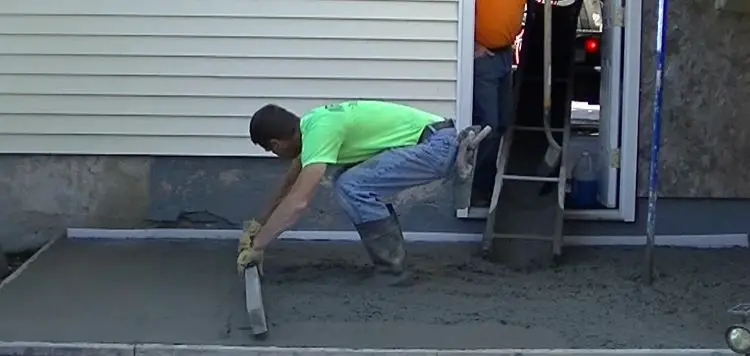
Yes, in the picture above I suggest pouring a thin layer of new concrete over an old concrete patio.
Remember, concrete has aggregate in it (rocks). The smallest rock size is about 3/8 inches. If you pour any thinner than 1.5 inches you don't have enough cement paste over and around the aggregate to get strong concrete.
The existing layer of concrete was over 20 years old. It was originally poured in multiple sections so it had some seams that looked like cracks.
The surface was badly worn and pitted, but the slab was structurally sound and there was ample height to pour new concrete right over the old one.
I poured the new slab 4 inches thick by the house and 1.5 inches (thin) by the lawn. This allowed me to get a 1.5-inch slope on the stamped concrete.
TOOLS USED TO POUR CONCRETE ON TOP OF CONCRETE
The tools I use to pour the new concrete slab are:
- A concrete screed
- Concrete rake (kumalong)
- Bull Float
- Mag float
- Shovel
- Extra chute
- Concrete boots
- Concrete gloves
IS IT OK TO POUR FRESH CONCRETE OVER PAINTED CONCRETE?
Yes, you can pour concrete over existing painted concrete, if the new concrete is 3 inches thick or more.
When pouring concrete over concrete, if the new concrete slab is less than 3 inches thick, it's best to bond the new concrete to the old concrete.
If the concrete is painted and you're pouring less than 3 inches of new concrete over it, you have to remove the paint (pressure wash it or grind it off) then apply a bonding agent to "glue" the new concrete to the old.
If the new concrete slab is 3 inches thick or more, then you want them to move (expand & contract) independently from each other. This is when we use a "bond breaker" between the old and new slabs.
You can leave the paint on the concrete, lay some plastic down, and pour the new concrete over both the paint and the plastic.
POURING CONCRETE OVER AN EXISTING CONCRETE DRIVEWAY OR SIDEWALK
The same principles as above apply to pouring concrete over an existing concrete driveway or sidewalk.
You can do it if the concrete is sound (solid) with minor cracks, pitting, scaling, surface damage, or just plain ugly.
You just have to factor in the added height. How will another 2, 3, or 4 inches in height affect door openings, stairs treads, abutting walkways, or garage floor heights?
If there's extensive settling, heaving, or cracking, I would want to investigate why it did that in the first place and correct that problem before I poured new concrete over something like that.
How Thin Can You Pour Concrete Over Concrete?
You can pour concrete as thin as 1/8" over old concrete slabs if you use a self-leveling concrete overlay mix. This type of concrete is specially designed for thinner pours of 1/8" - 1" thick.
If you need a level surface and your desired thickness is less than an inch, there's only one way to pour concrete correctly and that's by using a concrete overlay.
in conclusion:
Can I pour concrete over existing concrete? Yes, pouring new concrete over existing concrete can be a viable and effective solution to rejuvenate a worn or damaged surface, provided that the process is carried out correctly.
By thoroughly assessing the existing slab, preparing the surface, using appropriate bonding agents, and following the proper steps for pouring, finishing, and curing, a successful and lasting concrete overlay can be achieved.
Most popular pages:
